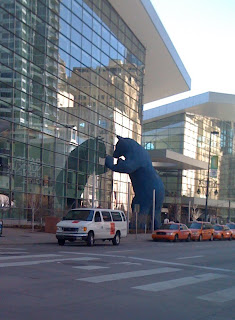An old chair. In this chair I have sat and watched sunsets, had good conversations with friends and loved ones, read many a book, cried some, and also had a good laugh or two. It is a good chair, the perfect height for the bend of my knee, sturdy in frame, but tired at the seams.
I had a friend tell me once of all the things writers could do instead of writing. He noted to me that a particular writer knew exactly how long it took to get a suit fitted, and that it was a favorite distraction. Perhaps deciding to recover the chair is a distraction. I don't know. I can't do it all at once, at least not now. I know how to cover a chair, knowledge not truly valued in the world of work and students, and because I know how to cover a chair, my mind can make all the architectural leaps necessary to adapt the craft of seaming, to the science of geometry and angles. I just can't make them all at once, all those calculations and executions. I can't dive in. I'm also in the middle of writing something, and I can't do that from dawn to dusk either. Why? I can only stay inside the writing hut in my mind for so long, and then it becomes a prison. I start to lose sense. I look at the chair, know already the pattern piece required to uniformly cut the curve of each arm, and I know I must break down each task in covering the chair into chunks, and engage the process a chunk at a time. If I stayed too long inside the world of covering the chair, it would be a prison too. I would start to lose sense and make mistakes. So, either recovering the chair is a necessary distraction from writing, or writing is a necessary distraction from covering the chair (two chairs actually--they're a set).
Why would one even want to attempt such a task? Why not buy new chairs? You would have to know me to understand why I don't give up on things, just because they show a little wear. Perhaps it was being raised by two depression-era survivors, my aunt and uncle (maybe). Perhaps it is because I'm too attached to objects (doubt it). Perhaps it is that I enjoy puzzles and the challenge of walking into the unknown, and creating a bridge back to the known (my, my, we are rather proud, aren't we?).
Well, whatever the reason, I can't give up on an item with good bones. How do I know it has good bones? The chairs don't give in the frame when I move them, even after 30 years of being moved about. This is something I learned from my uncle, who was skilled enough in carpentry to make his own cabinets. A chair of this design, with the ledge of the seat protruding from the front (the armrest and the leg do not comprise one, straight piece), has a sturdy frame. There's more wood in the frame, and more angles and braces supporting the entire structure of the chair, than there is in a chair of simpler design. The fabric may give out on this chair, but the frame won't.
So, aside from liking the chairs, I've decided they are serviceable pieces of furniture that I will keep, and that will keep me.
First up, making room for a zipper in my slip-covers, so I can remove them and wash them when necessary.
The zipper will hit the back of the chair, center.
What is already apparent to me is that I have an idea about piping and the general look of the finished cover, even though I don't have a sketch of that idea.
And, this is where I am stopping for today. Curves, ellipses, details, all floating in my mind, are left for the next day, the next session.
















































